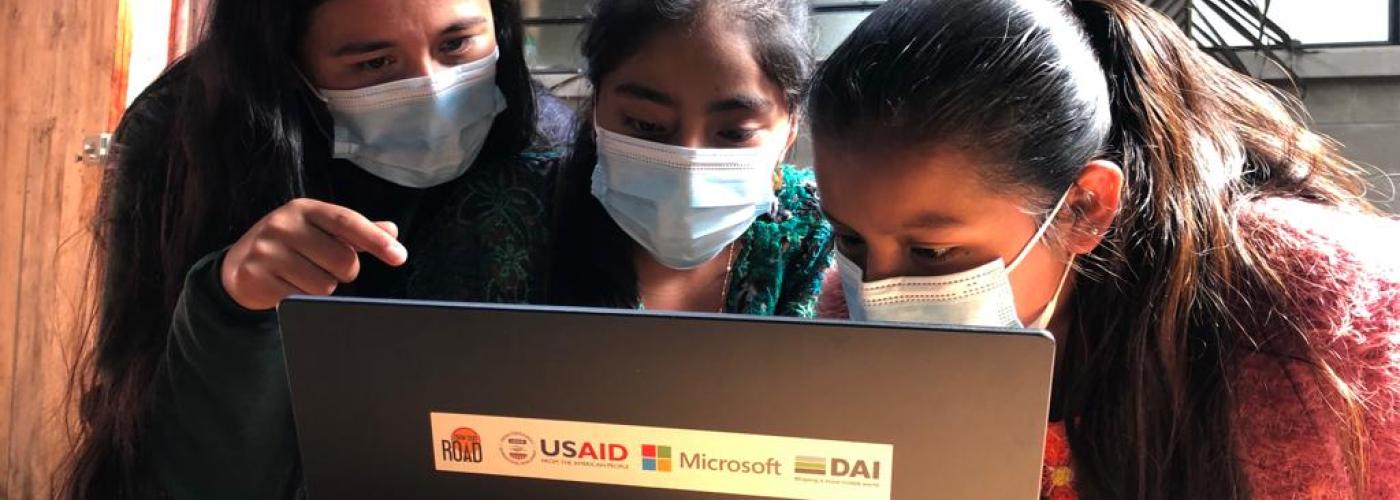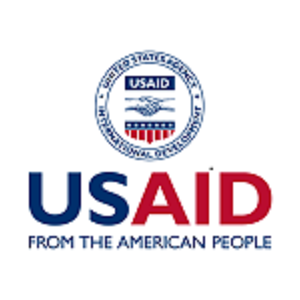Gaining Connection & Connectivity: Women Leaders Share Five Ways Digital Centers Impact Their Rural Communities in Guatemala
Image

Dulce Alejandra Tello sometimes felt isolated in her rural community near Coban, Guatemala and was always craving connection—and connectivity. When renewable energy company New Sun Road opened one of its Stellar Ixq-Saq'e Digital Community Centers (SIS Centers) in Dulce’s town of San Luis Chicoyou, she was eager to become involved.
“Since I was little, digital technology has always captured my attention,” reflected Dulce. “And then when I saw the opportunity to learn more [at the digital community center], I knew I couldn’t let the opportunity pass.” At 17-years old, Dulce became the youngest member of the San Luis Chicoyou Women’s Leadership Committee (WLC), which oversees the SIS Center’s operations and maintenance.
Across Guatemala’s Alta Verapaz region, the USAID/Microsoft Airband Initiative partnered with New Sun Road to establish ten SIS Centers and, in turn, ten WLCs to run them. A public-private partnership seeking to bridge the rural broadband gap and close the gender digital divide, the USAID/Microsoft Airband Initiative in Guatemala leverages local knowledge and partners to maximize impact.
For the success of the SIS Centers, New Sun Road—which specializes in accelerating renewable energy deployment and access for remote communities—focused on cultivating local ownership and leadership. For example, WLC members are democratically elected by their communities and vote on important SIS center details, such as pricing, opening hours, and additional services. The project’s approach to community-led development is proving effective, especially for the women leading the SIS Centers.
Below, WLC members share five key reflections and lessons learned from their involvement with the SIS Centers and the impact on their communities:
1. Improving digital literacy and knowledge.
“Before the project, I did not know how to use a computer… I only had brothers and I was in charge of doing all the housework. That was the only thing they taught me, and they did not give me the opportunity to study… I was afraid to touch cell phones and charge them… However, [now] I have learned many things.” – Estela Rax, Community Relations Leader, Sequila
Like Estela, many of the women who now staff the SIS Centers began their digital journeys with little to no background in technology. The project provided ongoing, hands-on (and often one-on-one) training on everything from the basics—turning on a computer and charging a cell phone—to the more complex—ensuring cyber safety and conducting online research.
“At first I did not know what my job functions really were,” shared Maria Tzul, Community Relations Leader in the community of San Antonio I. “But with the passing of time and all the trainings, now I really know how to do all this. I don’t just know how to turn on a computer; I know how to use Word, Excel, PowerPoint, and other programs,” she said.
Members of the WLCs are now passing along the digital knowledge they’ve gained to their families and communities, positioning themselves as trusted sources of information in the community.
2. Matching services to community needs.
“What I would like is for the Center to grow. I want the Center to continue offering opportunities for me and for my son. I hope he too can come here to the center to learn and… access all digital services within his own community.” – Zoila Yat, WLC Coordinator, San Antonio IV
Each of the ten SIS Centers offers a different array of services and has uniquely tailored pricing and business hours according to what the community needs or wants. For example, Zoila’s community of San Antonio IV is the only SIS Center open on a Sunday. San Antonio IV is home to a large church that draws attendees from the surrounding areas. Recognizing this, the community voted to staff the Center on Sundays.
“Normally 15 people come from the church all at once,” said Zoila. “Sometimes [during the week] only two people come to make photocopies. But on some occasions, especially Sundays, we have made 50 photocopies in one day.”
Members of WLCs realized quickly what services were most popular and helpful to their communities. Much of what the communities requested on a regular basis revolved around securing proper documentation: birth certificates, marriage certificates, tax forms, and personal identification for the National Registry of Persons (RENAP). While securing proper documentation might seem straightforward to some, before the SIS Centers, people in the Alta Verapaz region often had to travel long distances—even staying for days at a time—in order to find proper connectivity and printing for acquiring and submitting all the necessary forms.
“I didn’t know how to get this certificate from RENAP. But, this year, thank God that they taught us how to obtain it… This will help me for my future and in my future employment,” said Petrona Cucul, Service Leader in the community of Sequila.
Learning how to overcome even seemingly small hurdles, such as proper documentation, has had an exponential impact on access to opportunity.
3. Accessing new job opportunities.
“In my future I would like to put into practice what I am learning in my job at the center. I would like to teach. After this [work at the center], I can get a job, because now I have job experience... I feel very satisfied that I am a service leader. And I feel very happy I am an Indigenous leader.” – Petrona Cucul, Service Leader, Sequila
Petrona, who studied to be an intercultural bilingual early childhood education teacher, had all the education and skills she needed for her chosen profession. All she lacked was some formal experience to bolster her candidacy and the proper connectivity for researching and applying to open teaching positions. The SIS Centers helped expand and diversify the employment and income opportunities available to WLC leaders and members of their communities.
“Most of the WLC members have the knowledge they need,” commented Alejandro Alvarado, New Sun Road’s Project Manager. “But they don't have any formal experience. So, they don't get hired. We want to be that link so that they can get that experience.”
“I realized that even if you finish high school, you cannot get a job just with that, so I want to motivate young people to participate with us,” said Yesenia Yat Cho, Service Leader at San Antonio I. Yesenia, who provides childcare in her community, has used the Center for her work and personally to communicate with her husband, who lives and works abroad.
Some of the youngest WLC members, like Yesenia and Dulce, said their experiences with SIS Center leadership are significantly shaping their careers. In the future, Yesenia “would like to continue working with schools and working online.” As for Dulce, she plans to continue a career based in technology. “I would like [my dream job] to be related to technology,” she said. “I want to create or discover more.” Dulce has really enjoyed having opportunities—through the center and in her other studies—to explore different technology-adjacent careers such as programming and graphic design.
4. Amplifying local education efforts.
“In the future, I want all girls in our communities to learn how to operate computers… I want to teach all the students here how to handle technology and about all of the ways that it’s useful for us.” – Everlinda Sofia Cho, WLC Coordinator, San Antonio I
Across all ten communities, the SIS Centers have become a valuable resource for students, and one of the core responsibilities of the WLCs is to assist students with online homework assignments and research. Estela, who is President of the Primary Schools Commission in Sequila, has been instrumental in promoting the Center as a resource and model for integrating digital technology into local education.
“Local leaders have supported us building alliances with the schools,” said Estela. “[Education and local government officials] have been given the information that the Center is here, that children can come to complete their homework... There is a possibility that the [local] school will [be supplied with] 25 computers for the children. [The students] shared their stories that they already know how to use technology, and this sparked interest [in expanding].”
Across all SIS Centers, WLC leaders report that their most frequent customers are young people and students. “I feel like [this center] is something that is really needed and is going to be really fundamental for our youth and our children,” said Maria, the Communications Leader in San Antonio I. “Now our children don't have to go far to get information on the Internet or do their homework. They just come here.”
5. Forging new relationships and collaborating across communities.
“It was really fun to meet people from different places. We formed beautiful and lasting bonds, not only as colleagues, but as friends…There are always difficulties, and when we encounter one, we communicate and thus support each other.” – Dulce, Service Leader, San Luis Chicoyou
Collaboration between WLCs and across communities has enriched both the project and the WLC leaders’ experiences. Five WLC leaders from the SIS Centers, including Dulce, participated in a two-week, training program hosted by the municipal government of Coban and supported by New Sun Road and the USAID/Microsoft Airband Initiative.
“Oftentimes we don’t think about this, but people from the communities usually don’t know each other, because they’re so far apart,” said Alejandro. When they had the opportunity to convene, leaders from different communities were able to brainstorm, share experiences, and learn from each other.
A number of WLC members said they appreciated the opportunities to learn collectively and collaboratively. Over time, WLC members have also come to value the bonds they’ve forged with the project’s staff, expressing that these trusting relationships have made the learning process smoother and more fun.
“I want NSR to keep working with us,” shared Maria. “There is so much stuff that is left to learn, and I want to keep learning.”
What’s Next for the SIS Centers?
While their grant under the USAID/Microsoft Airband Initiative will end in March 2023, New Sun Road has a plan for both continued engagement and more community ownership moving forward. One of the key steps in this plan is to hire several WLC members, including Dulce and Petrona, on a more permanent basis.
“I was the lead coordinator of services in the Women's Leadership Committee. Now, I supervise three villages: Nimlajacoc, Corozal, and Sacoyou. I like helping women to use technology because most of them did not have the opportunity to study. The Internet is also helping the kids and young students,” said Violeta Chen, Supervisor, New Sun Road.
Under the USAID-MujerProspera Challenge, and with Microsoft’s support, New Sun Road is expanding to ten new sites in Huehuetenango and funding quarterly technical assistance to the Alta Verapaz WLCs.
“This project has really helped us,” observed Carlota Ical Pop, Finance Leader for San Antonio I. “Little by little more people hear about the services, and they visit more often. We've never had anything like this in our community. There is still more to do.”
__
As of December 2022, through the USAID/Microsoft Airband Initiative, New Sun Road has trained 1,375 women and girls in ten communities in Alta Verapaz, has worked with 187 women leaders, and has a plan to expand to other regions. Learn more about the women who are part of the project at https://dcc.newsunroad.com.
Photo Credit: New Sun Road
By Kendra Poole, Communications Specialist, DAI’s Digital Frontiers Project
The USAID/Microsoft Airband Initiative is implemented by DAI’s Digital Frontiers project, a buy-in mechanism that works closely with USAID Missions and Bureaus, the private sector, and international and local development organizations to identify successful and sustainable digital development approaches and scale their impact globally.


